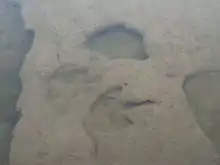Paluxy River
The Paluxy River, also known as Paluxy Creek, is a river in the U.S. state of Texas. It is a tributary of the Brazos River. It is formed by the convergence of the North Paluxy River and the South Paluxy River near Bluff Dale, Texas in Erath County and flows a distance of 29 miles (47 km) before joining the Brazos just to the east of Glen Rose, Texas in south central Somervell County.[1]

It is best known for numerous dinosaur footprints found in its bed near Glen Rose at the Dinosaur Valley State Park. The Paluxy River became famous for controversy in the early 1930s when locals found dinosaur and supposed human footprints in the same rock layer in the Glen Rose Formation, which were widely publicized as evidence against the geological time scale and in favor of young-Earth creationism. However, these anachronistic "human" footprints have been determined to be mistaken interpretation or hoaxes.[2][3]
Paluxy trackways

Many dinosaur trackways and footprints have been discovered in the riverbed, some as early as 1908. Most tracks in the area were found in Cretaceous limestone.[4] One of the most well-known is the chase sequence, which contains the tracks of a herd of sauropods and at least one theropod following the herd.[5] The tracks have been attributed to Sauroposeidon and Acrocanthosaurus, respectively. Other well-known and studied sites containing similar trackways are the Taylor Site, the Blue Hole Ballroom, and the Blue Hole Parlor.[5] In 1938, paleontologist Roland T. Bird discovered tracks in the Paluxy River. The documenting and publishing of these findings made the site famous and attracted the attention of researchers, some of whom began to claim that some of the tracks were human footprints.[4]
Alternative interpretations
The Paluxy River trackways have drawn much attention from supporters of creation and evolution alike.[4] Some claimed that some footprints were made by mythological giant humans who lived at the same time as the dinosaurs who created the other tracks.[6] John Whitcomb, Henry Morris, John Morris, and Carl Baugh all are current or former proponents of the human footprint hypothesis.[4] Though there are some that still cite the trackways as evidence against the geological time scale, the general consensus is that all of the human tracks were either fake or interpreted incorrectly.[4][7][8]
Some of the tracks were fake, carved by locals to sell during the Great Depression.[3] These footprints do not represent the way human footprints would look in mud; they also do not accurately reflect the changes in the way giant humans would walk as a result of their size.[6] Other footprints were genuine tracks, but showed features inconsistent with human footprints. Supporters of the human footprint hypothesis claimed that the tracks showed authentic mud “push-ups” and that the time period for the human and dinosaur trackways had to be the same as the trails intersected. In 1986, Glen Kuban conducted research on the trackways. He found that most tracks formed a wide “V” at the end and showed grooves in places that were not consistent with those in a human footprint. Kuban determined that the tracks were made by bipedal dinosaurs with three toes. These particular tracks showed the dinosaur walking on the soles of its feet rather than on its toes, as is usually found in tracks.[7] Evidence based in human anatomy also refutes the claim that the footprints are of human origin. The foot length measurements were used to calculate approximate heights of the humans; the pace and stride lengths do not match these calculated heights, making it highly unlikely that the tracks are human in origin. The measurements do fit the known values for bipedal dinosaurs.[6]
Other theories include random natural and erosion patterns resembling human footprints, trace fossils of burrows of small invertebrates, severely eroded or partial tracks, and other impressions known to occur in dinosaur trackways caused by different body parts.[6][7][8]
Digital recreation
In 2014, a digital model was made of the chase sequence trackways from photographs taken in 1940 by Bird. The photographs were used to create the digital reconstruction of the tracks as they were in 1940, before excavations. Though the reconstruction shows high variations in quality in different parts of the model, it provides a good demonstration of historical photogrammetry used to model deteriorated sites and specimens.[9]
See also
References
- Handbook of Texas, Paluxy River
- The Texas Dinosaur/"Man Track" Controversy, by Glen Kuban Talk.Origins
- Weber, Christopher Gregory. "Paluxy Man — The Creationist Piltdown". Creation/Evolution Journal, 1981, pp. 16–22.
- Branch, G. (2006). Paluxy Footprints. In H. J. Birx (Ed.), Encyclopedia of Anthropology (Vol. 4, p. 1818). Thousand Oaks, CA: SAGE Reference.
- Farlow, J. O., et al (2010). Dinosaur tracksites of the Paluxy River (Glen Rose Formation, Lower Cretaceous), Dinosaur Valley State Park, Somervell County, Texas, USA. Fifth Jornadas Internacionales sobre Paleontología de Dinosaurios y su Entorno, Salas de los Infantes, Burgos, Spain, pp. 15–16.
- Godfrey, L. R. (1985). "Foot Notes of an Anatomist". Creation/Evolution. 1. 5 (15): 16–36.
- Kuban, G (1986). "A Summary of the Taylor Site Evidence". Creation/Evolution. 6 (1): 10–18.
- Cole, J. R., Godfrey, L., & Schafersman, S. (1985). Mantracks? The Fossils Say No!. Creation/Evolution, 5, 37-45.
- Falkingham, P. L., Farlow, J. O. (2014). Historical Photogrammetry: Bird's Paluxy River Dinosaur Chase Sequence Digitally Reconstructed as It Was prior to Excavation 70 Years Ago. PLoS ONE 9(4)